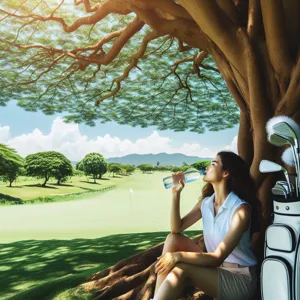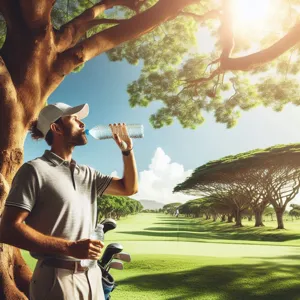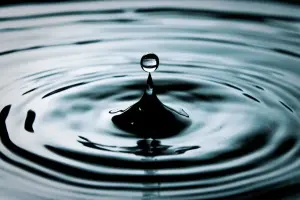As the sun rises over the lush greens and the sound of clubs striking balls fills the air, there’s nothing quite like a day on the golf course.
However, amidst the excitement of perfecting your swing and strategizing your next move, the importance of staying hydrated can often be overlooked. Golf is not just a leisurely stroll; it’s an endurance sport that requires focus, stamina, and energy. Without proper hydration, your performance could suffer, leaving you feeling fatigued or dizzy long before you reach the 18th hole. In this blog post, we’ll explore top tips for staying hydrated while enjoying a round of golf, ensuring that you remain at the top of your game. From clever drink choices to strategic hydration breaks, we’ll help you swing with success, keeping your body fueled and ready for every challenge that the course throws your way. So grab your clubs and let’s dive into the essentials of hydration for a day on the links!
1. The Importance of Hydration in Golf

### 1. The Importance of Hydration in Golf
When you think of golf, images of serene fairways, perfectly manicured greens, and the satisfying crack of a well-hit ball may come to mind. Yet, nestled within the beauty of the sport lies a crucial element that can make or break your game: hydration. Proper hydration is vital for golfers at all levels, as it directly influences performance, concentration, and overall well-being.
On a sunny day, spending several hours on the course can lead to significant fluid loss due to sweat, even if it doesn’t feel like it. Dehydration can sneak up on you, often manifesting as fatigue, reduced focus, and decreased coordination—each of which can severely affect your swing and putting accuracy. Studies have shown that even mild dehydration can impair cognitive functions and physical performance, making it even more challenging to execute those intricate shots or maintain your rhythm during play.
Moreover, the golf course is a dynamic environment, where shifting weather conditions can add to your hydration needs. Whether it’s the heat of summer or the chilling winds of autumn, understanding the importance of keeping your body well-hydrated is essential. Regularly sipping water or electrolyte-rich beverages not only helps maintain peak physical performance but also ensures that you’re mentally sharp, allowing for strategic decision-making on the course.
Ultimately, prioritizing hydration isn’t just about quenching your thirst; it’s about setting yourself up for success. By making a conscious effort to stay hydrated, you’ll find that your energy levels remain consistent, your focus sharpens, and your overall enjoyment of the game increases. So, as you prepare for your next round, remember: a well-hydrated golfer is a successful golfer.
2. Understanding Hydration Needs: How Much Water Do You Really Need?
Understanding your hydration needs is crucial for maintaining peak performance on the golf course. While it might seem straightforward, determining how much water you need can vary significantly based on several factors, including temperature, humidity, your level of exertion, and even your individual physiology. On a sweltering summer day, especially when the sun is blazing down and the humidity is high, your body may lose fluids at an alarming rate through sweat. This means that simply relying on thirst as a guide can be misleading; by the time you feel thirsty, you may already be on the verge of dehydration.
A good rule of thumb is to aim for about 16 to 20 ounces of water at least two hours before your round. During play, a general recommendation is to consume another 7 to 10 ounces every 15 to 20 minutes. However, these figures can change depending on how hot it is and how much you sweat. If you’re playing under the scorching sun or if you’re a particularly vigorous player, upping your intake is crucial.
Don’t forget to listen to your body. Signs of dehydration can include fatigue, dizziness, and dry mouth, but they can also manifest more subtly as reduced concentration or slower reaction times. If you notice these signs creeping in, make it a priority to take a break and hydrate. In addition to water, consider incorporating electrolyte-rich drinks, especially if you’re playing for an extended period or sweating profusely. These drinks can help replenish vital minerals lost through sweat and keep your energy levels up. By understanding and addressing your hydration needs, you’ll ensure that you stay sharp and focused throughout your game, swinging with success all the way to the 18th hole!
3. Choosing the Right Beverages: Water vs. Sports Drinks

When it comes to staying hydrated on the golf course, the type of beverage you choose can significantly impact your performance and overall well-being. The classic choice, water, is undoubtedly essential for quenching your thirst and maintaining hydration levels throughout your round. It’s calorie-free, widely available, and does an excellent job of replenishing the fluids lost through sweat, especially during those hot summer days when the sun beats down relentlessly on the fairways.
However, while water should be your go-to for regular hydration, sports drinks have their place in your golfing strategy, particularly during longer rounds or when temperatures soar. These beverages are designed to replace not just fluids, but also the electrolytes—like sodium and potassium—that your body loses through perspiration. When you’re out on the course for hours, those electrolytes can become crucial for maintaining your energy levels and preventing fatigue.
The key is to strike a balance. If you’re playing a quick nine holes or enjoying a leisurely round, water may suffice. But for those longer 18-hole stints or tournaments where concentration and endurance are paramount, consider incorporating a sports drink into your rotation. Look for options that are low in sugar and high in electrolytes to maximize benefits without the extra calories.
Ultimately, the right beverage choice will depend on your individual needs and the conditions of the day. Listen to your body—if you’re feeling fatigued or sluggish, it might be time to reach for that sports drink. Conversely, if your thirst simply calls for hydration, keep it classic with good old H2O. By making informed choices, you’ll not only stay hydrated but also enhance your game, swinging with success on every hole!
4. Pre-Round Hydration: Preparing Your Body Before You Tee Off
Pre-round hydration is a crucial component of your overall performance on the golf course. Just as you wouldn’t start a long road trip with an empty gas tank, your body needs to be adequately fueled with water before you step onto the tee. Hydrating in advance can significantly enhance your stamina, focus, and overall enjoyment of the game.
Begin your hydration routine the night before your round. Aim to drink at least 16-20 ounces of water to ensure your body is well-hydrated before the sun rises. This will not only help you avoid dehydration but also promote optimal physical functionality, as your muscles and joints will appreciate the extra fluid.
On the day of your tee-off, make it a point to consume another 8-10 ounces of water an hour before you hit the course. This will assist in ensuring your cells are saturated with hydration. If you’re prone to playing in the heat or are playing in particularly humid conditions, consider integrating electrolyte-rich drinks into your pre-round routine. Sports drinks or electrolyte tablets can help replenish the sodium and potassium lost during sweating, keeping your energy levels steady and minimizing muscle cramps.
It’s also wise to avoid alcohol and excessive caffeine before your round, as these can lead to dehydration. Instead, focus on consuming hydrating foods, such as watermelon or cucumbers, which can provide additional moisture to your system. By taking these proactive steps, you’ll set yourself up for success, ensuring that you’re not only ready to swing your clubs with confidence but also able to maintain your focus and energy levels throughout the entire round. Remember, a well-hydrated golfer is a successful golfer!
5. Keeping It Cool: Tips for Storing Your Drinks on the Course

When spending hours under the sun on the golf course, having a reliable method for keeping your drinks cool is essential for maintaining hydration and energy. Here are some tips to ensure your refreshments stay chilled, refreshing, and ready to enjoy after each swing.
First and foremost, invest in a high-quality insulated cooler or a thermos. These products are specifically designed to maintain the temperature of your beverages for extended periods, ensuring that your water, sports drinks, or iced tea are just the right temperature when you reach for them. Look for coolers that are compact and lightweight, making them easy to transport in your golf bag or cart.
Another effective strategy is to pre-chill your drinks before heading out to the course. This means placing your beverages in the refrigerator or freezer the night before your game. For an extra chill, consider adding ice packs or frozen water bottles to your cooler. As the ice melts, it will keep your drinks cool while also providing extra hydration as the ice water is consumed.
Don’t forget about the importance of timing. Aim to take sips of your drinks regularly rather than waiting until you feel thirsty. Keeping your drink close by and easily accessible can help encourage you to hydrate consistently throughout your round. If you’re using a golf cart, make sure the cooler is positioned within easy reach, or invest in a cup holder attachment that keeps your drink secure and cool.
Finally, consider the types of drinks you’re bringing along. Opt for beverages that not only hydrate but also replenish electrolytes lost during play. Coconut water, electrolyte-infused drinks, or even homemade iced herbal teas can provide that extra boost. With these tips in mind, you’ll not only stay cool but also keep your body fueled and ready for a successful day on the greens!
6. Hydration-Friendly Snacks to Bring Along
When you’re out on the golf course, maintaining hydration goes beyond just drinking water; the right snacks can play a crucial role in keeping your body fueled and your energy levels up. Packing hydration-friendly snacks ensures that you not only quench your thirst but also replenish essential nutrients lost during your rounds. So, what should you bring along?
First and foremost, consider fruits with high water content. Watermelon, oranges, and strawberries are not only refreshing but also provide a natural source of hydration. Their juicy texture makes them easy to consume between swings, delivering vitamins and minerals while keeping you refreshed. Additionally, you can opt for grapes or cucumber slices, which are also hydrating and can be easily packed in a cooler.
Next, think about nut butter packets paired with apple or banana slices. The combination of healthy fats, protein, and carbohydrates will help keep your energy stable throughout your game, while the fruit adds a juicy burst of hydration. Similarly, trail mix featuring nuts and dried fruits can be a satisfying snack; just be cautious with the dried fruits, as they can be high in sugar. Mixing in some dark chocolate chips can elevate your mood and provide a quick energy boost.
For a more substantial option, consider whole-grain wraps filled with hummus and fresh veggies. This savory snack is hydrating, packed with fiber, and will sustain you longer on the course. You can also prepare homemade energy balls with oats, honey, and seeds, which are perfect for a quick bite without the hassle of messy wrappers.
Lastly, don’t forget to pack a refillable water bottle alongside these hydrating snacks. Staying hydrated doesn’t just mean drinking water; it’s about making mindful choices that support your body while you enjoy every swing on the course. With the right snacks by your side, you’ll be ready to tackle all 18 holes with energy to spare!
7. Recognizing Signs of Dehydration on the Course

Recognizing the signs of dehydration on the course is crucial for maintaining your performance and ensuring your health while enjoying a day of golf under the sun. As you navigate the fairways and tackle each hole, your body is working hard, and it’s vital to listen to its signals.
One of the first indicators of dehydration is a feeling of thirst. If you find yourself reaching for your water bottle more frequently, it’s a clear sign that your body needs hydration. However, thirst isn’t the only warning sign; watch for other symptoms like dark yellow urine, dry mouth, fatigue, or dizziness. These can signal that your body is becoming dehydrated and that you need to replenish your fluids quickly.
Additionally, keep an eye on your energy levels. If you start feeling unusually tired or experience muscle cramps, it could be your body’s way of telling you that it’s not getting enough water. Golf requires focus and concentration, and dehydration can lead to diminished mental acuity and slower reaction times, impacting your game performance.
Being proactive is key. Make it a habit to check in with yourself regularly throughout your game. Carry a refillable water bottle and set a reminder to take a sip every few holes. By staying vigilant and recognizing these signs early, you can ensure that you remain hydrated, energized, and ready to swing with success on the course!
8. Setting Reminders to Drink Water During Your Round
Staying hydrated on the golf course is essential for maintaining peak performance, and one of the simplest yet most effective strategies is setting reminders to drink water throughout your round. It’s easy to become so immersed in your game that you lose track of time and neglect your hydration needs. So, how can you ensure that you’re sipping enough water while you play?
Start by leveraging technology to your advantage. Many smartphones come equipped with built-in reminder features or apps specifically designed to alert you at regular intervals. Set a reminder for every few holes, or even after every shot, to take a moment to hydrate. This not only keeps you accountable but also serves as a valuable pause to reflect on your swing and strategy.
If you prefer a more low-tech approach, consider using a simple wristband or even a watch to establish your hydration schedule. Every time you feel the band or glance at the time, take a sip from your water bottle. You might also enlist the help of a playing partner to remind you. A friendly nudge from a teammate can be a great motivator in the heat of the game!
Additionally, think about incorporating hydration breaks into your routine. Set specific points during your round—like after the 3rd and 6th holes—to take a quick break for water. This not only keeps you hydrated but also gives you a moment to regroup and assess your game.
Remember, staying hydrated isn’t just about drinking when you’re thirsty; it’s about proactively ensuring your body has the fluids it needs to perform at its best. By setting reminders to drink water during your round, you’ll stay energized, focused, and ready to swing with success!
9. How Weather Conditions Affect Your Hydration Needs
When you step onto the golf course, the weather can dramatically influence not only your game but also your hydration needs. Understanding how different weather conditions affect your body is crucial for maintaining peak performance and overall well-being.
On a sunny, hot day, the sun’s relentless rays can lead to rapid dehydration. As temperatures rise, your body works overtime to cool itself down, primarily through sweating. This loss of fluids can be significant, and if you’re not replenishing those lost electrolytes and water, you risk fatigue, dizziness, and diminished concentration. It’s essential to drink water frequently, ideally before you feel thirsty, and consider incorporating electrolyte-rich drinks to help maintain your body’s balance.
Conversely, on cooler, overcast days, you might not feel the immediate need to hydrate as you do in the heat. However, it’s a common misconception that you don’t need water when it’s chilly. In fact, the body can still lose moisture through respiration and perspiration, albeit at a slower rate. Staying hydrated is just as important during these cooler rounds, so be sure to keep sipping throughout your game, even if you don’t feel particularly thirsty.
Windy conditions can also play a role in your hydration strategy. The breeze may evaporate sweat quickly, giving you a false sense of dryness. This can lead to underestimating how much fluid your body is losing. Pay attention to how you feel and stay proactive with your hydration, adjusting your intake based on the strength of the wind and how it affects your comfort level.
In summary, whether you’re battling the sweltering sun, enjoying a cool breeze, or navigating the unpredictability of spring weather, always be mindful of how these factors impact your hydration. Keeping a close eye on the conditions will help you swing with success, ensuring that you stay refreshed and focused throughout your round.
10. The Role of Electrolytes in Maintaining Hydration
When it comes to staying hydrated on the golf course, it’s not just about drinking water; electrolytes play a crucial role in ensuring your body functions optimally, especially during those long rounds under the sun. Electrolytes—minerals like sodium, potassium, magnesium, and calcium—help regulate various bodily functions, including muscle contractions and nerve signaling. As you sweat on the course, you lose not only water but also these essential minerals, which can lead to fatigue, muscle cramps, and decreased performance.
To counteract this, incorporating electrolyte-rich beverages into your hydration plan can make a significant difference. Sports drinks, coconut water, or electrolyte tablets can provide the necessary replenishment to keep your energy levels up and your muscles working efficiently. These drinks not only hydrate but also help restore the balance of electrolytes lost through sweat, allowing you to maintain your focus and stamina throughout your game.
Additionally, consider snacking on foods high in electrolytes during your round. Bananas, avocados, and nuts are not just great for a quick energy boost; they also pack a punch in terms of essential minerals. By combining hydration with electrolyte replenishment, you’ll not only keep your body in peak condition but also ensure that you can swing with precision and confidence, making your day on the links even more enjoyable. So, the next time you hit the course, remember: water is key, but electrolytes are your secret weapon for staying sharp and playing your best!
11. Using a Hydration Pack or Water Bottle: Pros and Cons
When it comes to staying hydrated on the golf course, the method you choose to carry your fluids can significantly impact your overall experience and performance. Two popular options are hydration packs and traditional water bottles, each with its distinct advantages and drawbacks.
**Hydration Packs**: These versatile companions are designed to keep your hands free while ensuring a steady flow of water. Typically worn like a backpack, hydration packs feature a reservoir that holds a substantial amount of water, allowing you to sip through a tube as you navigate the course. The major advantage of a hydration pack is convenience; you can hydrate on the go without having to stop and reach for a bottle. This can be particularly beneficial during long rounds or in hot weather, as it encourages more frequent sips, helping to maintain your energy levels and focus.
However, hydration packs do come with some downsides. They can feel bulky or cumbersome, especially if you’re not accustomed to wearing one. Additionally, if you’re playing in a group, you may find that the sound of sloshing water or the tube can be distracting to your playing partners. Cleaning the pack can also require a bit more effort, as maintaining the reservoir and tubing is essential to prevent any unpleasant tastes or odors.
**Water Bottles**: On the other hand, traditional water bottles offer simplicity and ease of use. They’re lightweight, easy to carry, and come in a variety of sizes, making it easy to choose one that fits comfortably in your golf bag. Water bottles also allow for quick hydration breaks without the need to maneuver a tube or pack, and they can be easily refilled at water stations or in the clubhouse.
However, there are some drawbacks to using water bottles as well. Depending on your choice of bottle, you might not have enough water for an entire round, especially on hot days. Plus, if you forget to refill or misplace your bottle, you may find yourself in a hydration pinch.
Ultimately, the choice between a hydration pack and a water bottle comes down to personal preference and playing style. Consider your usual golfing conditions, the length of your rounds, and how much water you typically consume while playing. By weighing the pros and cons of each option, you can find the hydration solution that best suits your needs—ensuring that you stay refreshed and focused as you swing for success on the greens!
12. Hydration Tips for Hot Weather Golfing
When the sun blazes overhead and the temperatures soar, staying hydrated on the golf course becomes vital to your performance and enjoyment of the game. Hot weather can quickly drain your energy and concentration, making it essential to implement effective hydration strategies. Here are some practical tips to keep you well-hydrated while you navigate the greens.
First and foremost, start your day with a solid hydration routine. Before you even set foot on the course, drink at least 16 ounces of water or an electrolyte-replenishing beverage. This preemptive measure helps prepare your body for the heat and ensures you begin your game on the right foot.
As you play, aim to sip water regularly, rather than gulping down large amounts infrequently. A good rule of thumb is to drink about half a liter of water every hour, but listen to your body—if you feel thirsty, don’t wait until your next hole to hydrate. Keep a refillable water bottle handy in your golf bag, or take advantage of water stations that many courses provide.
In addition to water, consider incorporating electrolyte-rich drinks into your hydration strategy, especially if you’re playing for several hours. Sports drinks or coconut water can help replenish lost minerals and prevent fatigue. Look for options with lower sugar content to avoid an energy crash later.
Moreover, snack wisely on the course. Carrying hydrating fruits, such as watermelon, oranges, or cucumbers, can boost your fluid intake while providing essential vitamins and minerals. These snacks not only keep your body hydrated but also offer a refreshing break between holes.
Lastly, recognize the signs of dehydration—dry mouth, dizziness, and fatigue are all indicators that you need to drink up. By prioritizing hydration and being mindful of your intake, you’ll maintain your energy levels, enhance your focus, and swing with success even in the hottest conditions. Remember, a hydrated golfer is a happy golfer, ready to tackle every hole with vigor and enthusiasm!
13. Staying Hydrated During Long Rounds or Tournaments
Staying hydrated during long rounds or tournaments is crucial for maintaining both your physical performance and mental focus on the golf course. As you navigate from hole to hole, the sun can be relentless, and the combination of heat and exertion can lead to dehydration faster than you might expect. To ensure you stay at the top of your game, it’s important to have a hydration strategy in place.
Start by setting a hydration schedule before you even tee off. Aim to drink water consistently throughout your round, rather than waiting until you feel thirsty. A good rule of thumb is to sip on water or a sports drink every 15-20 minutes. This not only helps to ward off dehydration but also keeps your energy levels up, allowing you to maintain your swing and concentration longer.
Consider packing a well-insulated cooler or a thermos filled with ice-cold water or electrolyte-rich drinks to keep your hydration options refreshing throughout the day. Many golfers find that adding a pinch of salt or electrolyte tablets to their water can help replenish lost minerals, especially on particularly hot days.
Don’t forget about the importance of fueling your body alongside hydration. Healthy snacks like nuts, granola bars, or fruit can provide the energy boost you need while also promoting hydration, particularly fruits with high water content like watermelon or oranges.
Lastly, be mindful of the signs of dehydration, such as fatigue, dizziness, or headaches. If you experience any of these symptoms, take a break, find some shade, and hydrate immediately. By prioritizing your hydration strategy during long rounds or tournaments, you’ll not only enhance your performance but also enjoy your time on the course to the fullest. Swing with success, knowing that you’re taking the right steps to keep your body and mind in peak condition!
14. Incorporating Hydration into Your Pre-Golf Routine
Incorporating hydration into your pre-golf routine is essential for optimizing your performance on the course. Just like you wouldn’t step onto the tee without your clubs, you shouldn’t step onto the green without proper hydration. Begin your day with a glass of water as soon as you wake up; this simple act kickstarts your metabolism and replenishes any fluids lost during the night.
As you prepare for your round, make hydration a key component of your warm-up. Consider sipping on an electrolyte-infused drink, which not only hydrates but also replenishes essential minerals that can enhance your endurance and stamina. Aim to consume around 16 ounces of fluids about an hour before you tee off. This will ensure that your body is primed and ready for the physical demands of the game ahead.
During your practice swings and putting drills, keep a water bottle nearby and take regular sips. Developing this habit will not only keep you hydrated but also serves as a mental cue to focus on your hydration strategy throughout the entire round. Remember, proper hydration helps maintain your energy levels, sharpens your concentration, and keeps fatigue at bay. By prioritizing hydration from the very beginning of your golfing experience, you’ll set yourself up for a day of swinging with success, all while enjoying the beautiful outdoor setting of the course.
15. Conclusion: Swinging with Success through Proper Hydration
In conclusion, maintaining proper hydration is not just an afterthought on the golf course; it’s a fundamental aspect of achieving peak performance and enjoying your time under the sun. As you navigate the lush fairways and challenging greens, remember that each swing, putt, and drive demands optimal physical and mental readiness. By prioritizing hydration, you equip yourself with the stamina and focus needed to tackle each hole with confidence and vigor.
As you implement the tips shared throughout this post—from carrying a reliable water bottle and setting hydration reminders to consuming hydrating snacks and being mindful of the weather conditions—you’ll find yourself better prepared to face whatever challenges the game throws your way. Hydration doesn’t just enhance your performance; it elevates your overall experience on the course, allowing you to savor every moment, every swing, and every conversation with your fellow golfers.
So, as you gear up for your next round, take a moment to reflect on your hydration strategy. Swinging with success is about more than just technique; it’s about giving your body the fuel it needs to thrive. With a commitment to staying hydrated, you’ll not only improve your game but also enjoy a more fulfilling and enjoyable day on the links. Here’s to a refreshing round of golf—cheers to staying hydrated and swinging with success!
As we wrap up our exploration of staying hydrated on the golf course, remember that maintaining optimal hydration is essential for both your performance and enjoyment of the game. By implementing these top tips—such as planning your hydration strategy, choosing the right beverages, and setting reminders—you’ll be well-equipped to beat the heat and keep your energy levels up from the first tee to the final putt. Staying hydrated not only enhances your focus and stamina but also contributes to your overall health on and off the course. So, grab your water bottle, take those sips between swings, and step onto the fairway with confidence. Here’s to many successful rounds ahead, where every swing is accompanied by the refreshing satisfaction of being properly hydrated! Happy golfing!





